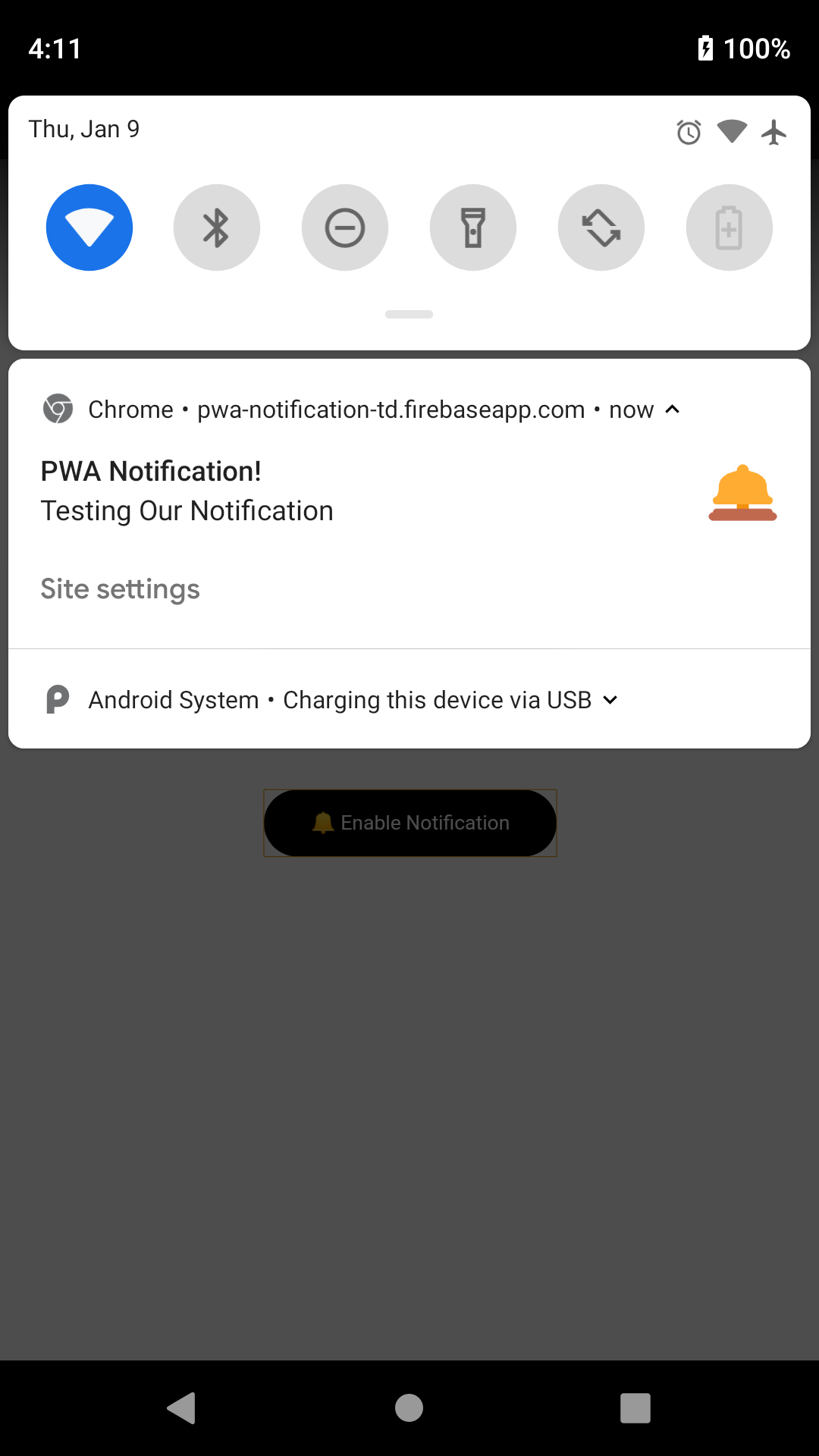如何向 PWA 添加通知
您是否想过如何将那些烦人(但有用)的通知添加到您的渐进式 Web 应用程序中?
那么在本教程中,我将向您展示如何操作!
我们正在建造什么?
现场演示
https://pwa-notification-td.firebaseapp.com/
开始之前
我们将使用通知 API
通知 API:通知 API 的通知接口用于配置和向用户显示桌面通知。这些通知的外观和具体功能因平台而异,但通常都提供了一种异步向用户提供信息的方式。
*注意:*通知 API 与推送 API 不同。
是时候动手了
1)克隆此 repo:
https://github.com/devpato/pwa-notifications
2) 您将看到 3 个文件夹。其中最重要的是 START 文件夹和 FINAL 文件夹。在 FINAL 文件夹中,您可以看到最终的代码,但出于本教程的目的以及您的学习目的,我们只需关注 START 文件夹即可。
3)导航到脚本文件夹内的 main.js 文件
4)添加以下代码:
const notificationButton = document.getElementById('enableNotifications');
let swRegistration = null;
notificationButton是在我们的应用中触发通知的按钮。如果您访问 index.html,您将看到我已经为您创建的按钮。
swRegistration只是一个存储我们的服务工作者的全局变量。
注意: sw.js 文件位于根文件夹中。Service Worker 就位于根目录中。
5)现在让我们创建一个名为initializeApp的函数。此函数将处理应用程序首次加载时需要触发的所有内容。
//First, we check if having service workers and notifications are //supported.
function initializeApp() {
if ('serviceWorker' in navigator && 'PushManager' in window) {
console.log('Service Worker and Push is supported');
//Register the service worker
navigator.serviceWorker
.register('../../sw.js')
.then(swReg => {
console.log('Service Worker is registered', swReg);
// We are storing the service worker, globally
swRegistration = swReg;
})
.catch(error => {
console.error('Service Worker Error', error);
});
} else {
console.warn('Push messaging is not supported');
notificationButton.textContent = 'Push Not Supported';
}
}
要了解有关 PushManger 的更多信息,请访问:https://developer.mozilla.org/en-US/docs/Web/API/PushManager
6) 应用首次加载时,我们需要调用initializeApp()函数。为此,请在函数声明之前添加调用。
7) 现在我们需要创建一个名为initializeUi的新函数。该函数如下所示:
function initializeUi() {
notificationButton.addEventListener('click', () => {
//Do something here
});
}
此函数的唯一目的是将点击事件附加到notificationButton。因此,当用户点击按钮时,就会发生一些事情。
8) 现在在 initializeApp() (我们之前创建的函数) 内部,我们在swRegistration = swReg;表达式之后立即调用initializeUi(); :
function initializeApp() {
...
navigator.serviceWorker
.register('../../sw.js')
.then(swReg => {
....
// We are storing the service worker, globally
swRegistration = swReg;
initializeUi();
})
...
}
通过这样做,一旦服务工作者注册成功,我们将初始化 UI。
9)现在该创建一个名为displayNotification的新函数了。该函数如下所示:
function displayNotification() {
//Ask user if we show notifications
if (window.Notification && Notification.permission === 'granted') {
//notification();
// We will create this function in a further step.
}
// If the user hasn't told whether he wants to be notified or not
// Note: because of Chrome, we cannot be sure the permission property
// is set, therefore it's unsafe to check for the "default" value.
else if (window.Notification && Notification.permission !== 'denied') {
Notification.requestPermission(status => {
if (status === 'granted') {
//notification();
} else {
alert('You denied or dismissed permissions to notifications.');
}
});
} else {
// If the user refuses to get notified
alert(
'You denied permissions to notifications. Please go to your browser or phone setting to allow notifications.'
);
}
}
10) 回到点击回调中的 initializeUi() 方法,找到“Do something here”这个提示。将这一行替换为:
displayNotification();
您的代码将如下所示:
function initializeUi() {
notificationButton.addEventListener('click', () => {
displayNotification();
});
}
11)最后,我们将创建一个通知功能,其中将包含我们想要在通知中显示的信息。
function notification() {
const options = {
body: 'Testing Our Notification',
icon: './bell.png'
};
swRegistration.showNotification('PWA Notification!', options);
}
12) 在displayNotification()函数内部,你会看到我们正在调用notification(),但它被注释掉了。只需取消注释即可触发代码。
13)最终代码如下:
https://github.com/devpato/pwa-notifications/blob/master/final/scripts/main.js
14) 在浏览器中测试通知。如果您想在真实设备上测试,则需要部署它并确保已部署的应用使用https进行服务。您可以使用Firebase 托管来实现这一点。
你可能已经注意到,我们注册了一个 Service Worker,但因为没有必要,所以没有添加任何代码。在下一个教程中,我们将使用 Service Worker 进行更多操作。在该教程中,我将向你展示如何使用Firebase Cloud Messaging从服务器发送推送通知。所以,稍等片刻,我们将探索更多关于 Service Worker 的功能 ;)
使用 Firebase(云消息传递)的 PWA 推送通知-pt1
文章来源:https://dev.to/thisdotmedia/how-to-add-notifications-to-your-pwa-2mmg 后端开发教程 - Java、Spring Boot 实战 - msg200.com
后端开发教程 - Java、Spring Boot 实战 - msg200.com

